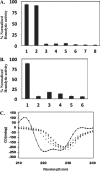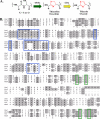Clostridiolysin S, a post-translationally modified biotoxin from Clostridium botulinum
- PMID: 20581111
- PMCID: PMC2934687
- DOI: 10.1074/jbc.M110.118554
Clostridiolysin S, a post-translationally modified biotoxin from Clostridium botulinum
Abstract
Through elaboration of its botulinum toxins, Clostridium botulinum produces clinical syndromes of infant botulism, wound botulism, and other invasive infections. Using comparative genomic analysis, an orphan nine-gene cluster was identified in C. botulinum and the related foodborne pathogen Clostridium sporogenes that resembled the biosynthetic machinery for streptolysin S, a key virulence factor from group A Streptococcus responsible for its hallmark beta-hemolytic phenotype. Genetic complementation, in vitro reconstitution, mass spectral analysis, and plasmid intergrational mutagenesis demonstrate that the streptolysin S-like gene cluster from Clostridium sp. is responsible for the biogenesis of a novel post-translationally modified hemolytic toxin, clostridiolysin S.
Figures





Similar articles
-
Diversity of the Genomes and Neurotoxins of Strains of Clostridium botulinum Group I and Clostridium sporogenes Associated with Foodborne, Infant and Wound Botulism.Toxins (Basel). 2020 Sep 11;12(9):586. doi: 10.3390/toxins12090586. Toxins (Basel). 2020. PMID: 32932818 Free PMC article.
-
Genomes, neurotoxins and biology of Clostridium botulinum Group I and Group II.Res Microbiol. 2015 May;166(4):303-17. doi: 10.1016/j.resmic.2014.10.010. Epub 2014 Nov 4. Res Microbiol. 2015. PMID: 25445012 Free PMC article. Review.
-
Streptolysin S-like virulence factors: the continuing sagA.Nat Rev Microbiol. 2011 Aug 8;9(9):670-81. doi: 10.1038/nrmicro2624. Nat Rev Microbiol. 2011. PMID: 21822292 Free PMC article. Review.
-
Regulation of toxin synthesis in Clostridium botulinum and Clostridium tetani.Toxicon. 2013 Dec 1;75:90-100. doi: 10.1016/j.toxicon.2013.06.001. Epub 2013 Jun 13. Toxicon. 2013. PMID: 23769754
-
Characterization of nontoxic-nonhemagglutinin component of the two types of progenitor toxin (M and L) produced by Clostridium botulinum type D CB-16.Microbiol Immunol. 1995;39(7):457-65. doi: 10.1111/j.1348-0421.1995.tb02229.x. Microbiol Immunol. 1995. PMID: 8569530
Cited by
-
HIV protease inhibitors block streptolysin S production.ACS Chem Biol. 2015 May 15;10(5):1217-26. doi: 10.1021/cb500843r. Epub 2015 Feb 20. ACS Chem Biol. 2015. PMID: 25668590 Free PMC article.
-
Microbial competition between Bacillus subtilis and Staphylococcus aureus monitored by imaging mass spectrometry.Microbiology (Reading). 2011 Sep;157(Pt 9):2485-2492. doi: 10.1099/mic.0.048736-0. Epub 2011 Jun 30. Microbiology (Reading). 2011. PMID: 21719540 Free PMC article.
-
A systematic analysis of biosynthetic gene clusters in the human microbiome reveals a common family of antibiotics.Cell. 2014 Sep 11;158(6):1402-1414. doi: 10.1016/j.cell.2014.08.032. Cell. 2014. PMID: 25215495 Free PMC article.
-
Insights into the mechanism of peptide cyclodehydrations achieved through the chemoenzymatic generation of amide derivatives.J Am Chem Soc. 2013 Jun 12;135(23):8692-701. doi: 10.1021/ja4029507. Epub 2013 May 30. J Am Chem Soc. 2013. PMID: 23721104 Free PMC article.
-
Orchestration of enzymatic processing by thiazole/oxazole-modified microcin dehydrogenases.Biochemistry. 2014 Jan 21;53(2):413-22. doi: 10.1021/bi401529y. Epub 2014 Jan 7. Biochemistry. 2014. PMID: 24364559 Free PMC article.
References
-
- Severinov K., Semenova E., Kazakov A., Kazakov T., Gelfand M. S. (2007) Mol. Microbiol. 65, 1380–1394 - PubMed
-
- Datta V., Myskowski S. M., Kwinn L. A., Chiem D. N., Varki N., Kansal R. G., Kotb M., Nizet V. (2005) Mol. Microbiol. 56, 681–695 - PubMed
-
- Humar D., Datta V., Bast D. J., Beall B., De Azavedo J. C., Nizet V. (2002) Lancet 359, 124–129 - PubMed
Publication types
MeSH terms
Substances
Grants and funding
LinkOut - more resources
Full Text Sources
Other Literature Sources

